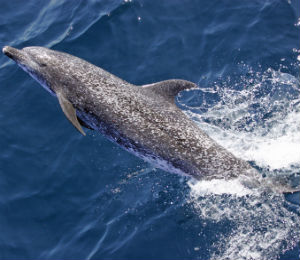Experience the wonder of Freeport dolphin tours, providing unforgettable opportunities to get up close and personal with some of the most captivating creatures in the sea. One of the most entertaining of boating companions, the Atlantic spotted dolphin is an agile, speedy swimmer, noted for its love of leaping and flipping playfully out of the water.
Atlantic Spotted Dolphin Appearance
Known for its swift swimming and joyful bow-riding, the Atlantic spotted dolphin loves to visit passing boats, providing entertaining aerial displays and great photo opportunities. Reaching lengths of close to eight feet at maturity, these relatively small dolphins weigh in at around 250 to 350 pounds. They have a long, slim snout, a high, strongly curved dorsal fin, a stocky head and body and relatively large flippers.
The Atlantic spotted dolphin is named for the coloration patterns on its body, and there is a lot of variation in the size, density and color of the spots, with region and ocean depth contributing to the spotting factor. Overall color of spotted dolphin calves appears as dark gray on the back and white on the underside, with sides blending into a light gray. As the dolphin matures, spots appear on the flanks and bellies, showing as dark on white areas and white on dark areas, becoming more and more plentiful as the animal reaches maturity. Some individuals, however, have few spots, so it can be hard to properly identify some members of the species.
Atlantic Spotted Dolphin Eating Habits
Like most members of the dolphin family, Atlantic spotted dolphins feed mostly on small fish, as well as octopus, anchovies, eels, snakefish, razorfish and ballyhoo. In shallow water they may also hunt bottom fish and squid. Dolphins usually hunt at night and use a type of sonar called echolocation to locate potential prey, as well as to identify underwater structures and natural predators. Social creatures, dolphins may track their prey either individually or as a group, communicating by a series of sounds that we hear as underwater pings, whistles, chirps and barks.
Atlantic Spotted Dolphin Habitat
The Atlantic bottlenose lives in the tropical and temperate areas of the Atlantic Ocean. They tend to inhabit an area no deeper than 100 fathoms from the surface, as they are voluntary breathers and need to rise to the surface periodically. Most prevalent around the western part of the Gulf Stream between Bermuda and Florida, Atlantic spotted dolphins can also be found along the sandbanks of the Bahamas.
This dolphin species, like most in the family, lives social groups called pods, which may range from six to ten individuals up to groups of 50. Within the larger pod are numerous subgroups, ranging from mother and calf pairs to juvenile, male and female groups. Overall, males bond most tightly, working together for purposes of herding, coordinating courtship and protecting the pod from natural predators such as sharks and killer whales. Pods are very social groups, working together for hunting, travel, discipline and protection while also allowing plentiful time for playing. They are very protective of pregnant females and calves and have been known to work as a group to help injured comrades.

